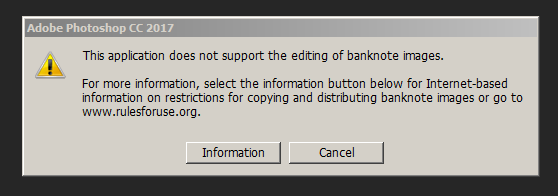During a recent project to design for an article on the Panama Papers I encountered an error that I had not seen before. The concept of the original design used different forms of currency from all over the world. Historically, Photoshop and similar applications have been used to forge documents and money. It turns out that Adobe has programmed safeguards into their software to prevent illegal usage of their product.

This was pulled from Getty Images' Thinkstock division. I figured that this would be an ideal background with the varied amount of documents. When opening it, I received this error.

Fortunately, Getty Images was able to refund me the credits used when purchasing this image. But the point is to watch out for these kinds of images. If the photograph or scan is clear enough, Photoshop will recognize it and prevent you from opening it.
Research into this topic uncovered some very interesting results when it comes to the reproduction of United States issues documents. The Rules for Use website is specifically set up to inform the public what is acceptable and what isn't when handling currency from around the globe.
The Central Bank Counterfeit Deterrence Group (CBCDG) is a group of 32 central banks and note printing authorities organized at the request of the Governors of the G10 central banks. Its mission is to investigate the common emerging threats to the security of banknotes, and to propose solutions for implementation by issuing authorities.
At their request, Adobe Systems implemented the use of the CBCDG's Counterfeit Detection System (CDS) algorithm in their products (year citation needed) despite voluntarily adding it beforehand.
Rulesforuse.org is an excellent source of information when designing with money and should always be referenced when doing so. According to the website, there are some countries that completely forbits any use of currency outside of banknotes. That includes artistic and advertising situations. Fortunately the United States is a little more forgiving. Think of how boring movies like Ocean's Eleven would've been if they couldn't use money. Or how expensive it would've been if they needed to produce all those millions of dollars for show.
Taken from the United States' Counterfeit Detection Act of 1992, Public Law 102-550, in Section 411 of Title 31 of the Code of Federal Regulations, permits color illustrations of U.S. currency, provided that:
- the illustration is of a size less than three-fourths or more than one and one-half, in linear dimension, of each part of the item illustrated;
- the illustration is one-sided; and
- all negatives, plates, positives, digitized storage medium, graphic files, magnetic medium, optical storage devices and any other thing used in the making of the illustration that contain an image of the illustration or any part thereof are destroyed and/or deleted or erased after their final use.
For a graphic designer, the fact that there are only a few minor regulations on this topic from the United States is rather reassuring. For most designers, the requirements that depictions are 75% or less, or 150% or more, the size of actual bank notes and that they must be one-sided is not really going to be an issue. A primary target for this information should probably be students. Only having graduated less than a decade ago I can remember how easy it was for students, no fault of theirs, to be ignorant of legal regulations like this.
On the other hand, unlike the European Union's Euro currency, the United Kingdom's Pound Sterling is strictly forbidden to be reproduced (under the Forgery and Counterfeiting Act 1981) without written consent provided by the Bank of England. This includes anything that is considered for satire.
Conclusion Here

